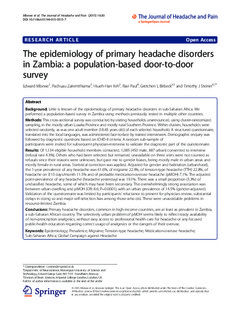| dc.description.abstract | Background
Little is known of the epidemiology of primary headache disorders in sub-Saharan Africa. We performed a population-based survey in Zambia using methods previously tested in multiple other countries.
Methods
This cross-sectional survey was conducted by visiting households unannounced, using cluster-randomized sampling, in the mostly urban Lusaka Province and mostly rural Southern Province. Within clusters, households were selected randomly, as was one adult member (18-65 years old) of each selected household. A structured questionnaire, translated into the local languages, was administered face-to-face by trained interviewers. Demographic enquiry was followed by diagnostic questions based on ICHD-II criteria. A random sub-sample of participants were invited for subsequent physician-interview to validate the diagnostic part of the questionnaire.
Results
Of 1,134 eligible household members contacted, 1,085 (450 male, 887 urban) consented to interview (refusal rate 4.3%). Others who had been selected but remained unavailable on three visits were not counted as refusals since their reasons were unknown, but gave rise to gender biases, being mostly male in urban areas and mostly female in rural areas. Statistical correction was applied. Adjusted for gender and habitation (urban/rural), the 1-year prevalence of any headache was 61.6%, of migraine 22.9%, of tension-type headache (TTH) 22.8%, of headache on ≥15 days/month 11.5% and of probable medication-overuse headache (pMOH) 7.1%. The adjusted point-prevalence of any headache (headache yesterday) was 19.1%. There was a small proportion (5.3%) of unclassified headache, some of which may have been secondary. The overwhelmingly strong association was between urban dwelling and pMOH (OR: 8.6; P=0.0001), with an urban prevalence of 14.5% (gender-adjusted). Validation of the questionnaire was limited by participants’ reluctance to present for physician review, substantial delays in doing so and major self-selection bias among those who did. These were unavoidable problems in resource-limited Zambia.
Conclusions
Primary headache disorders, common in high-income countries, are at least as prevalent in Zambia, a sub-Saharan African country. The selectively urban problem of pMOH seems likely to reflect ready availability of non-prescription analgesics, without easy access to professional health care for headache or any focused public-health education regarding correct usage of analgesics or the dangers of their overuse. | nb_NO |

